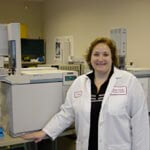
San Antonio (June 15, 2004) – She’s quick to point out that her job isn’t quite as glamorous as the forensic detective work depicted on CBS-TV’s “CSI.” But Tiffany Flowers, a 2003 graduate of the clinical laboratory sciences graduate degree program in toxicology at The University of Texas Health Science Center at San Antonio, is making her own mark in the Bexar County Toxicology Laboratory and Medical Examiner’s Office.
Among other duties, Flowers is identifying suspect chemicals and drugs, carbon monoxide poisoning and signs of drug abuse in autopsy specimens at the Bexar County Forensic Science Center. She recently was profiled in the Texas Association for Clinical Laboratory Science newsletter.
Flowers is one of six toxicology chemists in the Toxicology Lab and ME’s Office. According to the newsletter article, the Forensic Science Center “is one of the busiest forensic centers in the state and performed 300 autopsies in the first six weeks of the year.”
Her master’s degree thesis was a study of gamma-hydroxybutyric acid (GHB), which has been called a “date rape drug” because it may be used for drug-facilitated sexual assault, said her project mentor, George B. Kudolo, PhD, associate professor and coordinator of the graduate toxicology program in the Health Science Center’s department of clinical laboratory sciences.
“Sometimes these incidents end in death and an important issue is the interpretation of the postmortem results if GHB is present,” Dr. Kudolo said. “This is because there is a strong possibility of a postmortem production of GHB in the body, even in the absence of prior consumption before death. So, if postmortem GHB is found, it is important to know the contribution of the body’s own production of GHB.”
Flowers assessed three methods of measuring GHB in blood and urine samples. Each yields different analytical results. “Identifying the most reliable methods will obviously be very important for forensic toxicologists, who must interpret these results and help medical examiners determine the cause of death in a ‘drug-facilitated’ sexual assault case,” Dr. Kudolo said.
“My data fell in line with other studies that have been done,” Flowers said. “A method called liquid-liquid TMS proved to be superior to the other methods. In the forensic toxicology community, this should be very helpful.”
GHB is considered a schedule one controlled substance, which means possession is a crime. Therefore, the outcome of these forensic tests could make the difference between incarceration and freedom for living suspects.
“Tiffany’s findings are important contributions to understanding this date rape drug’s effects and its detection,” said Shirlyn McKenzie, Ph.D., professor and chair of the department of clinical laboratory sciences. The department is part of the School of Allied Health Sciences at the Health Science Center.
Flowers is helping to develop the quality assurance plan for the Toxicology Lab. Her first contact with the lab came when she completed an internship there during her master’s degree program. The Bexar County Forensic Science Center is located on the Health Science Center’s Central Campus in the South Texas Medical Center.

